Never miss another geomagnetic storm. Sign up for Space Weather Alerts and you'll receive a text message when magnetic storms erupt. Aurora tour guides and professional astronomers use this service. You can, too! | | |
X-FLARE! Earth-orbiting satellites have just detected an X1-class solar flare (Oct. 2nd @ 2025 UT). Ironically, it did not come from big dangerous sunspot AR3112, described below, but rather from AR3110, a smaller and apparently less threatening active region. The flare (image) produced a shortwave radio blackout over the Pacific Ocean and parts of North America (blackout map), and it may have hurled a CME into space. Stay tuned for updates. Solar flare alerts: SMS Text
A BIG DANGEROUS SUNSPOT: One of the biggest sunspots in years has just rotated over the sun's northeastern limb. Introducing, AR3112:
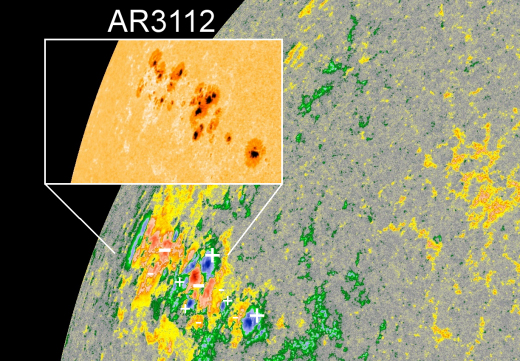
AR3112 has more than a dozen dark cores scattered across 130,000 km of solar terrain, making it an easy target for backyard solar telescopes. Don't have a solar filter? Use the projection method, instead.
The image above is a magnetic map of the sun's surface with a white light photo of AR3112 inset. It shows what makes this sunspot group so dangerous. Positive and negative magnetic polarities are bumping together--an explosive mixture that could produce an X-class solar flare.
The emergence of AR3112 already fully formed and unstable could herald two weeks of high solar activity as the sunspot group transits the solar disk, facing Earth the whole time. Stay tuned.
Solar flare alerts: SMS Text Realtime Space Weather Photo Gallery
Free: Spaceweather.com Newsletter
STERLING SILVER HUMMINGBIRD PENDANT: This hummingbird has touched space. On Sept. 22, 2022, the students of Earth to Sky Calculus launched the sterling silver pendant to the stratosphere onboard a cosmic ray research balloon, more than 117,710 feet high:
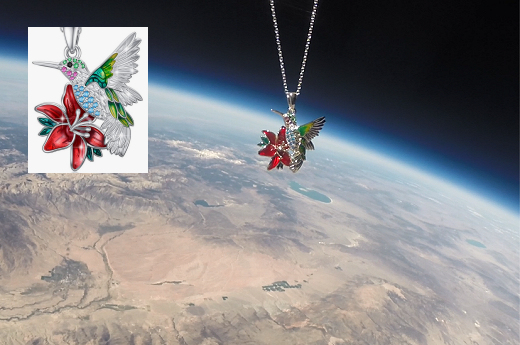
You can have it for $149.95. The students are selling hummingbird pendants to pay the helium bill for their cosmic ray ballooning program. Each one comes with a greeting card showing the bird and red lily in flight, and telling the story of their trip to the stratosphere and back again.
Far Out Gifts: Earth to Sky Store
All sales support hands-on STEM education
THE AURORA THAT'S NOT AN AURORA: On Sept. 26th, a CME struck Earth's magnetic field. During the resulting geomagnetic storm (G2), auroras spread as far south as Missouri. Upon closer inspection, some of the auroras were not auroras. Here is an example from Glidden, Wisconsin:
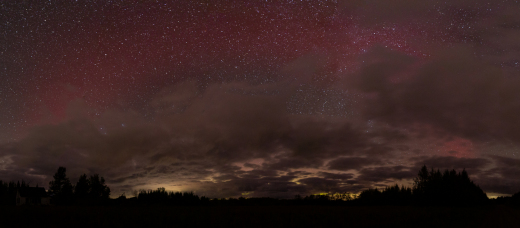
"I knew the storm was happening, so I headed out to capture the Milky Way with some aurora thrown in," says photographer Michele Sadauskas. "With my first click, I knew something was up. Everything was RED! I happily captured this gigantic SAR arc that went from east to west in the sky."
SARs are red arcs of light that ripple across the sky during some geomagnetic storms. They were discovered in 1956 at the beginning of the Space Age. Researchers didn’t know what they were and unwittingly gave them a misleading name: "Stable Auroral Red arcs" or SARs.
In fact, SARs are neither stable nor auroras. Auroras appear when charged particles rain down from space, hitting the atmosphere and causing it to glow like the picture tube of an old color TV. SARs form differently. They are a sign of heat energy leaking into the upper atmosphere from Earth’s ring current system--a donut-shaped circuit of plasma carrying millions of amps around our planet.
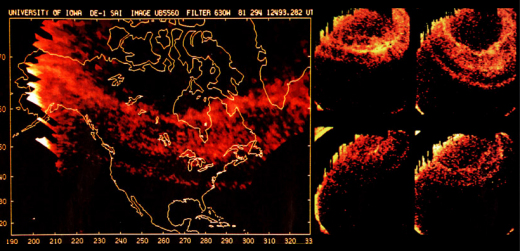
Above: SARs photographed by the Dynamics Explorer-1 satellite in 1982. More
SARs are among the reddest things in the sky, with a monochromatic glow at 6300 Å that comes from atomic oxygen in the upper atmosphere. The human eye is relatively insensitive to light at this wavelength, but cameras can record the color easily. Pro tip for photographers: Use a 6300 Å filter.
more images: from Jeff Berkes of Bayfield, Wisconsin; from Bill Kocken of McGregor, Minnesota
Realtime Aurora Photo Gallery
Free: Spaceweather.com Newsletter
Every night, a network of
NASA all-sky cameras scans the skies above the United States for meteoritic fireballs. Automated software maintained by NASA's Meteoroid Environment Office calculates their orbits, velocity, penetration depth in Earth's atmosphere and many other characteristics. Daily results are presented here on Spaceweather.com.
On Oct 02, 2022, the network reported 7 fireballs.
(7 sporadics)
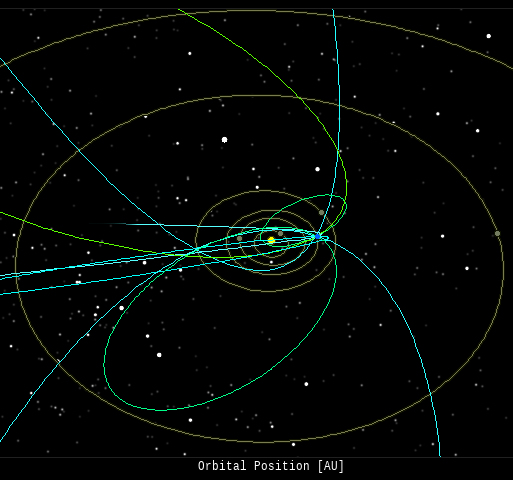
In this diagram of the inner solar system, all of the fireball orbits intersect at a single point--Earth. The orbits are color-coded by velocity, from slow (red) to fast (blue). [Larger image] [movies]
Potentially Hazardous Asteroids (
PHAs) are space rocks larger than approximately 100m that can come closer to Earth than 0.05 AU. None of the known PHAs is on a collision course with our planet, although astronomers are finding
new ones all the time.
On October 2, 2022 there were 2298 potentially hazardous asteroids.
 |
Recent & Upcoming Earth-asteroid encounters: | Asteroid | Date(UT) | Miss Distance | Velocity (km/s) | Diameter (m) |
| 2022 SV21 | 2022-Sep-27 | 1.4 LD | 12.2 | 8 |
| 2022 SY2 | 2022-Sep-27 | 18.8 LD | 12.8 | 46 |
| 2022 SD10 | 2022-Sep-27 | 3.1 LD | 22.9 | 13 |
| 2022 SJ11 | 2022-Sep-27 | 5.4 LD | 18.4 | 19 |
| 2022 SZ2 | 2022-Sep-27 | 1.5 LD | 3.6 | 10 |
| 2022 ST3 | 2022-Sep-27 | 18 LD | 17.5 | 32 |
| 2022 SD4 | 2022-Sep-27 | 10.7 LD | 9.8 | 18 |
| 2022 SP4 | 2022-Sep-27 | 15.6 LD | 13.2 | 52 |
| 2022 SO4 | 2022-Sep-28 | 13.6 LD | 11.5 | 27 |
| 2022 SB11 | 2022-Sep-28 | 15.3 LD | 12.1 | 29 |
| 2022 SP1 | 2022-Sep-28 | 19 LD | 4.6 | 20 |
| 2022 SZ10 | 2022-Sep-28 | 12.9 LD | 7.3 | 11 |
| 2022 ST7 | 2022-Sep-28 | 10.8 LD | 5.2 | 30 |
| 2022 SZ | 2022-Sep-28 | 13.7 LD | 7.4 | 18 |
| 2022 SR1 | 2022-Sep-29 | 12.1 LD | 6 | 25 |
| 2016 HF2 | 2022-Sep-29 | 19.2 LD | 5.6 | 21 |
| 2022 SA12 | 2022-Sep-29 | 3.7 LD | 10.6 | 9 |
| 2022 SH12 | 2022-Sep-29 | 3.5 LD | 14.8 | 14 |
| 2022 SG11 | 2022-Sep-29 | 2.8 LD | 18.9 | 13 |
| 2022 SP43 | 2022-Sep-29 | 19.9 LD | 11 | 22 |
| 2022 SJ9 | 2022-Sep-29 | 3.2 LD | 9.9 | 12 |
| 2022 SU7 | 2022-Sep-30 | 1.9 LD | 4.9 | 8 |
| 2022 SW24 | 2022-Sep-30 | 1.2 LD | 10.8 | 8 |
| 2022 SB12 | 2022-Oct-01 | 2.4 LD | 11.2 | 12 |
| 2022 SD25 | 2022-Oct-01 | 7.8 LD | 9.4 | 16 |
| 2022 SB9 | 2022-Oct-01 | 5.2 LD | 8.8 | 20 |
| 2022 SZ9 | 2022-Oct-01 | 1.5 LD | 7.7 | 8 |
| 2018 ER1 | 2022-Oct-02 | 14.7 LD | 4 | 27 |
| 2022 SL28 | 2022-Oct-03 | 4.3 LD | 13.2 | 11 |
| 2022 SC9 | 2022-Oct-03 | 13.3 LD | 15.3 | 43 |
| 2022 SM21 | 2022-Oct-04 | 4.9 LD | 15.1 | 12 |
| 2022 SO11 | 2022-Oct-04 | 2.9 LD | 12.4 | 15 |
| 2018 VG | 2022-Oct-05 | 18.5 LD | 6.7 | 12 |
| 2022 SJ28 | 2022-Oct-05 | 14.9 LD | 9.2 | 19 |
| 2021 TJ10 | 2022-Oct-06 | 19.6 LD | 8.1 | 6 |
| 2013 TJ6 | 2022-Oct-07 | 11.7 LD | 14.4 | 32 |
| 2022 SU21 | 2022-Oct-08 | 3.2 LD | 20 | 41 |
| 2022 SB29 | 2022-Oct-09 | 4.6 LD | 7.6 | 15 |
| 2022 SV11 | 2022-Oct-09 | 17.1 LD | 14.4 | 35 |
| 2022 SE10 | 2022-Oct-10 | 5.5 LD | 10.9 | 29 |
| 2022 RA5 | 2022-Oct-12 | 13.1 LD | 5.1 | 38 |
| 2022 SG6 | 2022-Oct-13 | 15.7 LD | 10.9 | 88 |
| 2013 SL20 | 2022-Oct-14 | 6.2 LD | 12.1 | 45 |
| 2022 SY10 | 2022-Oct-15 | 6.4 LD | 3.2 | 15 |
| 2022 SK48 | 2022-Oct-15 | 17.7 LD | 10.3 | 57 |
| 2020 TO2 | 2022-Oct-15 | 1.4 LD | 12.6 | 18 |
| 2020 BD | 2022-Oct-16 | 12.1 LD | 11.4 | 20 |
| 2022 SK15 | 2022-Oct-16 | 9.5 LD | 15.9 | 57 |
| 2022 QM6 | 2022-Oct-17 | 19.8 LD | 4.2 | 69 |
| 2022 RB5 | 2022-Oct-22 | 13.1 LD | 5.3 | 115 |
| 2005 AZ28 | 2022-Oct-24 | 11.5 LD | 5.4 | 48 |
| 2016 TH94 | 2022-Oct-25 | 19.1 LD | 13.5 | 43 |
| 2019 AN5 | 2022-Oct-27 | 20 LD | 6.8 | 215 |
| 2004 UT1 | 2022-Oct-29 | 4 LD | 6.3 | 17 |
| 2021 VH | 2022-Nov-01 | 5.9 LD | 5.3 | 4 |
| 2022 RM4 | 2022-Nov-01 | 6 LD | 23.5 | 443 |
| 2020 WD | 2022-Nov-08 | 3 LD | 6 | 8 |
| 2019 XS | 2022-Nov-10 | 16.7 LD | 11.9 | 60 |
| 2019 VL5 | 2022-Nov-15 | 8.5 LD | 8.1 | 24 |
| 2018 WH | 2022-Nov-16 | 2.5 LD | 7.7 | 4 |
| 2019 OR1 | 2022-Nov-21 | 18.1 LD | 13.4 | 246 |
| 2005 LW3 | 2022-Nov-23 | 3 LD | 13.5 | 168 |
Notes: LD means "Lunar Distance." 1 LD = 384,401 km, the distance between Earth and the Moon. 1 LD also equals 0.00256 AU. | | Cosmic Rays in the Atmosphere |
SPACE WEATHER BALLOON DATA: Almost once a week, Spaceweather.com and the students of Earth to Sky Calculus fly space weather balloons to the stratosphere over California. These balloons are equipped with sensors that detect secondary cosmic rays, a form of radiation from space that can penetrate all the way down to Earth's surface. Our monitoring program has been underway without interruption for 7 years, resulting in a unique dataset of in situ atmospheric measurements.
Latest results (July 2022): Atmospheric radiation is decreasing in 2022. Our latest measurements in July 2022 registered a 6-year low:
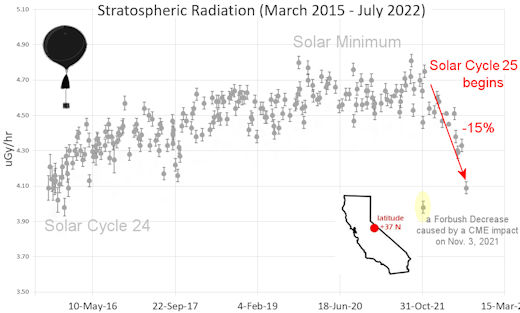
What's going on? Ironically, the radiation drop is caused by increasing solar activity. Solar Cycle 25 has roared to life faster than forecasters expected. The sun's strengthening and increasingly tangled magnetic field repels cosmic rays from deep space. In addition, solar coronal mass ejections (CMEs) sweep aside cosmic rays, causing sharp reductions called "Forbush Decreases." The two effects blend together to bring daily radiation levels down.
.Who cares? Cosmic rays are a surprisingly "down to Earth" form of space weather. They can alter the chemistry of the atmosphere, trigger lightning, and penetrate commercial airplanes. According to a study from the Harvard T.H. Chan school of public health, crews of aircraft have higher rates of cancer than the general population. The researchers listed cosmic rays, irregular sleep habits, and chemical contaminants as leading risk factors. A number of controversial studies (#1, #2, #3, #4) go even further, linking cosmic rays with cardiac arrhythmias and sudden cardiac death.
Technical notes: The radiation sensors onboard our helium balloons detect X-rays and gamma-rays in the energy range 10 keV to 20 MeV. These energies span the range of medical X-ray machines and airport security scanners.
Data points in the graph labeled "Stratospheric Radiation" correspond to the peak of the Regener-Pfotzer maximum, which lies about 67,000 feet above central California. When cosmic rays crash into Earth's atmosphere, they produce a spray of secondary particles that is most intense at the entrance to the stratosphere. Physicists Eric Regener and Georg Pfotzer discovered the maximum using balloons in the 1930s and it is what we are measuring today.
| | The official U.S. government space weather bureau |
| | The first place to look for information about sundogs, pillars, rainbows and related phenomena. |
| | Researchers call it a "Hubble for the sun." SDO is the most advanced solar observatory ever. |
| | 3D views of the sun from NASA's Solar and Terrestrial Relations Observatory |
| | Realtime and archival images of the Sun from SOHO. |
| | information about sunspots based on the latest NOAA/USAF Active Region Summary |
| | current counts of failed and deployed Starlink satellites from Jonathan's Space Page |
| | Authoritative predictions of space junk and satellite re-entries |
| | from the NOAA Space Environment Center |
| | fun to read, but should be taken with a grain of salt! Forecasts looking ahead more than a few days are often wrong. |
| | from the NOAA Space Environment Center |
| | the underlying science of space weather |
 | BestCSGOGambling is the best site for everything related to CSGO gambling on the web |
 | To find reviews of new online casino sites in the UK try The Casino DB where there are hundreds of online casino reviews complete with bonuses and ratings. Alternatively, Online-Casinos.xyz is another massive directory of online casinos listing sites for the UK and Worldwide. Casinos that offer Rupees for bonuses are very generous to Indian players. Find the best online casinos in India at AllCasinos.in Looking for a new online casino? Try Casimpo the new site dedicated to making online casino simple, or check out the new Avenger Slots Casino and Ace Online Casino with over 500 online slots and casino games. |
 | One of the most popular casino games is the Book Of Dead Slot based on ancient Egyptian text, you can find all the casinos with spins at bookofdeadslotsites.com. |
 | When looking for casinos to play online when the weather is bad, you can try casino online trucchi for Italian games. If you are not from Finland you can try the Swedish page Svenska casino online to find suitable games, check out svenskacasinoonline.net. Always check your local laws before playing with real money. |
 | Looking for sports betting companies not registered on GamStop? CasinoGap has presented a list of sites not on GamStop available for UK players. Check and bet online! Would you like to bet at sites not using GamStop? Look at a list of NonStopCasino sites for online betting that aren't on GamStop. Top-rated bookmakers ever! |
| | These links help Spaceweather.com stay online. Thank you to our supporters! |
| | | | | | |

